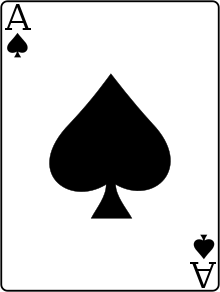Ace (playing card)

The ace , in southern German also the ace, according to the old spelling As , abbreviated to A , from the old French / Latin as ( a unit ), is a card value in the French hand and in most card games the highest card. The equivalent in the German newspaper is the Daus .
Special features of the card
The card has a symbol ( ♠ ♦ ♥ ♣ ) corresponding to the color of the game in the middle of the French hand , which is partly decorated. In the case of German papers, such as the Bavarian or the Württemberg one, however, there are illustrations in the middle that have only loose or no relation to the color of the game. Most of them are allegorical depictions, the double German sheet depicts the four seasons using four female figures.
The UK ace of spades
In 1624, a tax on documents and printed matter, including playing cards, was introduced in the Netherlands . William III. of Orange adopted this idea when he became King of England, Ireland and Scotland. He introduced the "stamp duty" (stamp duty) to finance his war with France. Originally intended as a temporary measure, the profitable tax was retained and administered by a separate authority, which was later absorbed by the tax authority. From 1712 onwards, people started stamping the ace of spades by hand in a deck of cards to prove that the tax had been paid. From 1765 on, the ace of spades was printed by the authorities and the elaborate design was given the royal coat of arms. In the lower part of the card there was also a reference to the manufacturer of the card game. Manipulation or forgery of the card could result in severe penalties. From 1862 the tax stamp in the game itself was dispensed with and banderoles were used for the packaged deck of cards. The manufacturers retained the elaborate design of the ace of spades, however, instead of the tax certificate, they now combined self-promotion with the card. - The German manufacturer ASS (Altenburg Spielkarten), on the other hand, uses the ace of hearts to mark its products.
Special features in the game
The ace can be used as a number 1 card in card games or as the highest card. In games such as poker or blackjack , the player has the choice of the value of the ace: In poker, depending on the best possible combination with other cards, the ace counts either as 1 or as the highest card following the king . So it can be with the Ass both the road A- 2 - 3 - 4 - 5 and 10 - J - Q - K -A form. In blackjack, the player can choose whether he wants to score the ace as 1 or 11 . In seventeen and four , a similar card game to blackjack, for example, the ace always counts as 11. In rummy , the special rule applies similarly to poker.
In the Doppelkopf , the diamond aces have a special role ("foxes").
Trivia
- The ace of spades is often used in American pop culture .
- In 1980 the British rock band Motörhead released the album Ace of Spades with the song of the same name. "Ace of Spades" is the English name for the ace of spades.
- In France, the ace is often printed with the number 1 instead of an A. This custom comes from the French Revolution , where it was supposed to demonstrate the victory of the common people over the authorities after the 1 was used as a trump card over the king's card. In the tarot game, popular since the 15th century , the ace or “1” is the smallest playing card at the end of the wrong color row.
- In the card game Personality Identification Playing Cards , on whose playing cards the 52 most wanted Americans in Iraq in 2003, the ace of spades adorns the image of Saddam Hussein .
Web links
Individual evidence
- ↑ Bavarian Dictionary, 4th issue, Apostel - Atmetzer, 1998, Sp. 637.
